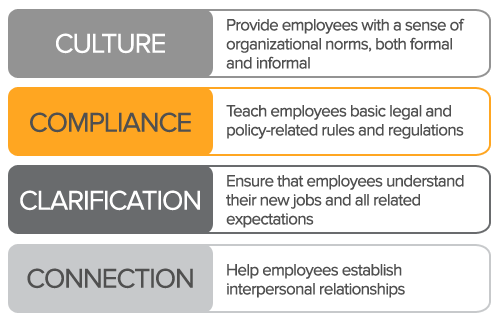Finding, hiring and retaining great employees is hard. That's why the moment you find a person who has the potential to be your next A-player, it’s important to initiate a well-composed and thought-out onboarding process.
Businesses often refer to onboarding and orientation interchangeably, but there is a significant difference. Orientation is typically a one-time class or session which occurs in the first few hours or days on the job where new hires complete required payroll and benefits paperwork, are introduced to company rules and policies and may participate in a facility tour.
In contrast, onboarding is a PROCESS that occurs over a period of time which begins as early as the first personal contact or job interview through the employee’s first year on the job. Onboarding is about making social connection and the payoff can be huge.
If you design and consistently execute a thoughtful onboarding process, it will engage new hires in a way that enables them to begin contributing quickly, become more strongly connected to their co-workers and customers, and helps them understand their role in the company and how they can impact success. Ultimately, this leads to overall improved satisfaction, reduced employee turnover and increased productivity.
The Society for Human Resources Management has identified 4 elements to incorporate into the design of a successful onboarding program:
 Once your program is designed, incorporate these best practices when executing the onboarding process to increase the impact of the time and effort you and your employees have invested:
Once your program is designed, incorporate these best practices when executing the onboarding process to increase the impact of the time and effort you and your employees have invested:
- Start immediately – Take advantage of the opportunity to begin sharing your company, your culture and your expectations with hew hires. You never get a second chance to make a first impression.
- Involve multiple people – Onboarding is not solely the responsibility of the HR department or the hiring manager. Include others to lead to give the new hire multiple perspectives and the chance to create meaningful connections.
- Spread the events over a scheduled timeline – Pre-boarding, orientation, job training, 30-day check-in conversations, new hire surveys and stay interviews are great ways to continue engaging employees and ensuring they know you care and also provide them with the opportunity to ask questions.
- Develop checklists – Use tools to support the onboarding process to ensure a consistent experience for your team members, regardless of when they join the company or who is leading their onboarding.
- Employ creativity – Use a variety of methods to share information and create connection. Make it memorable.
Above all, remember that onboarding is a journey. Make your employees’ trip compelling so that each and every one of them will remember the experience because it affirms why they joined your company in the first place.
Ultimately, onboarding can help your employees see how they fit into their role in your organization and, at the end of the day, they will still be happy that they chose to come to work for you.


